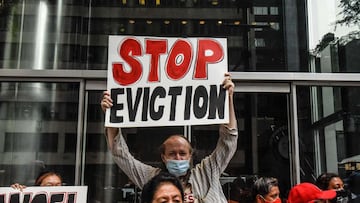How many evictions are there in the US each year?
The CDC has announced an extension to the eviction moratorium which has protected millions of renters from eviction throughout the pandemic.


Despite a last-minute extension to the eviction moratorium, there is concern that the number of Americans facing eviction in the United States is a crisis brewing.
Matthew Desmond, professor in the Department of Sociology at Princeton University and author of the book ‘Evicted’, estimates that there are roughly one million evictions in a typical year in America.
This sees around 2.3 million people removed from their homes every year, and the economic consequences of the pandemic will likely lift that higher once the eviction moratorium is eventually removed.
Read more
- Eviction moratorium extended: what's the new date and how many people will benefit?
- How have stimulus checks helped Americans’ cash reserves?
New moratorium provided by the CDC
It had appeared that the renters’ protection would expire at the end of July, when the legislation passed by President Biden in the American Rescue Plan was due to end. The White House had insisted that they were powerless to extend it in the face of a Supreme Court ruling, while Democrats in Congress knew they did not have the votes to approve an extension.
The two-month extension is the product of a decision by the Centers for Disease Control and Prevention to state that a wave of evictions would only serve to accelerate the spread of the more infectious Delta variant and would constitute a public health crisis.
The Biden admin issued a temporary halt on evictions in parts of the country after Democratic leaders protested the previous moratorium expiring https://t.co/lkGzd4C4za
— NowThis (@nowthisnews) August 5, 2021
As such the new moratorium is different to its predecessor in that the ban on evictions only applies in counties “experiencing substantial and high levels of community transmission levels” of the coronavirus. Currently, this is thought to cover around 80% of renters, and roughly 90% of all Americans.
The latest figures from the Census Bureau suggest that 1.4 million households are ‘very likely’ to face eviction in the next two months, with another 2.2 million warning that they are ‘somewhat likely’ to be evicted.
Concern that states will face an ‘avalanche’ of evictions when protection ends
Although the CDC’s decision will provide extra breathing space for struggling households there is concern that, unless the flailing rental assistance programmes are made more efficient, the extension simply delays the inevitable.
The federal government passed $47 billion of rental support to help struggling renters cover their monthly payments, but only 6.5% of that money has so far been distributed. When the moratorium is eventually lifted renters could be immediately liable for the entirety of their unpaid rent, which could go back months.
NEW: A U.S. Landlord group is asking a federal judge to immediately strike down the eviction moratorium arguing that the CDC "caved" to political pressure
— Sean Langille (@SeanLangille) August 5, 2021
In late June and early July, census data found that around 12.7 million renters were unsure if they would be able to make their upcoming rent payment. Making matters worse, the eviction protocol varies greatly between states with some Americans having nearly no protection once the moratorium ends.
Related stories
Florida, for example, requires renters in arrears to repay the full amount of overdue rent within just five days of their landlord’s eviction filing. Failure to do so means that they are denied the right to a court hearing and they could well be out in the streets within a week.
Dr Ned Murray, associate director of the Florida International University Metropolitan Center, voiced his concern: “Evictions were already high before the pandemic, but with the end of the moratorium we’re facing an avalanche of evictions because so many renters are not just in a position to pay their current rent but also pay their back rent.”

